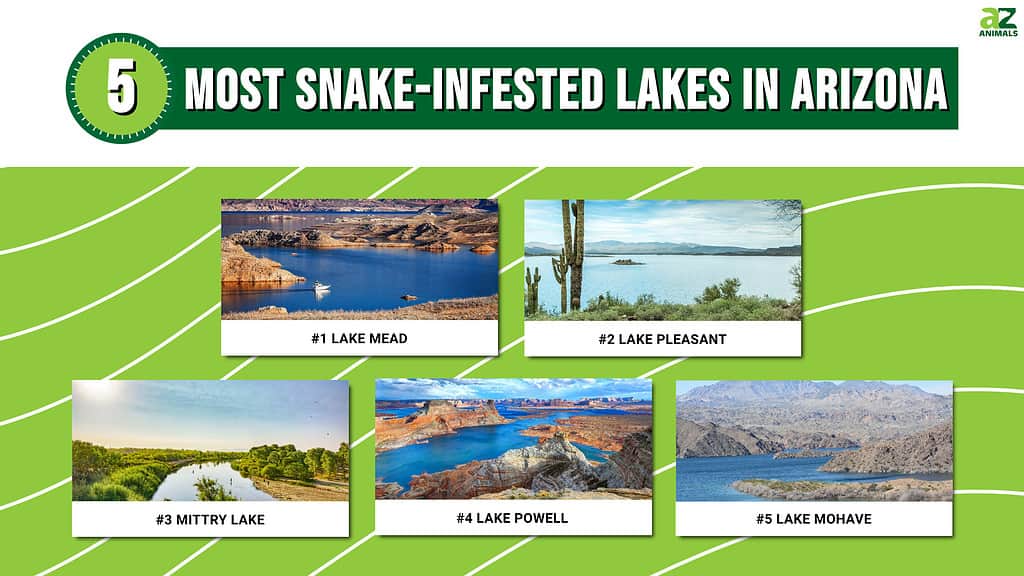
Arizona is a diverse state in landscape, ecosystem, and wildlife. The state features a range of plants, animals, and natural wonders that fascinate locals and visitors. It’s home to forested mountains, arid deserts, volcanic plateaus, glaciated summits, lava fields, semi-arid plains covered in grass and shrubs, river alluvial floodplains, and of course, canyonlands.
The state’s northeastern region is one-quarter of the Four Corners. Southeast Utah, Southwest Colorado, and Northwestern New Mexico are other parts of the area. Warm winters and extremely scorching summers characterize the desert environment in Southern Arizona.
Large, deep canyons, the Colorado Plateau, Douglas Fir, mountain ranges (including the San Francisco Mountains), spruce trees, and pine forests all exist within Northern Arizona, along with the Grand Canyon. The steep-sided, vibrant gorge formed by the Colorado River is one of the Seven Natural Wonders of the World.
Arizona is a dream come true for every hunting, exploring, and outdoors enthusiast. Native fauna, including small and large mammals and reptiles, are abundant in the state. Residents and visitors are likely to encounter a snake, particularly in the southern part around Phoenix and Scottsdale.
With over 50 snake species (14 of which are venomous), Arizona has the second-highest snake diversity after Texas. There are 36 distinct rattlesnake species present in most of the 50 states. The Grand Canyon State hosts 14 of these species, more than in any other state.
Water Snakes Found in Arizona Lakes

The western diamondback rattlesnake is not a water snakes, despite their tendency to be encountered near water bodies.
©Audrey Snider-Bell/Shutterstock.com
The western diamondback and the gopher snake are two snake species mostly spotted in Arizona. However, neither of these are water snakes, despite their tendency to be encountered near water bodies.
There are no native water snake species in Arizona, but one species has been introduced to the state. The invasive banded water snake is the only water snake species found in Arizona.
Most Snake-Infested Lakes in Arizona
The beautiful lakes of Arizona often attract many people who enjoy the great outdoors. However, it’s important to identify those that may not be suited for a safe swim. These are the most snake-filled lakes in Arizona.
#1 Lake Mead
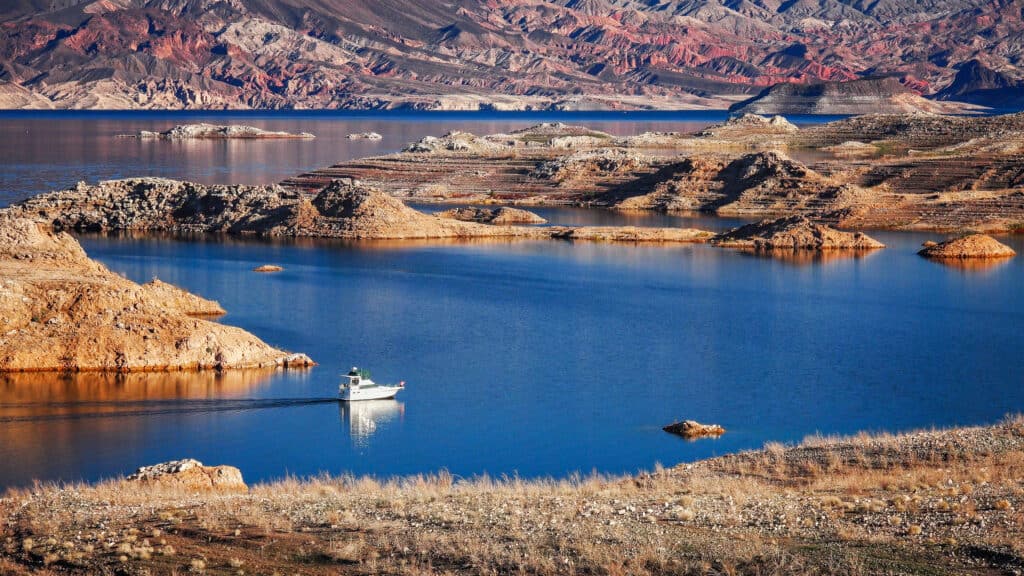
According to the National Park Service, the Lake Mead National Recreation Area is home to 41 reptile species, including snakes.
©iStock.com/CrackerClips
The popular Lake Mead is the country’s largest reservoir created by the Hoover Dam construction on the Colorado River, and it’s shared by Arizona and Nevada in the southwest U.S. Its coastline spans over 750 miles and provides opportunities for a range of recreational activities, including swimming, water skiing, fishing, boating, and sunbathing. Camping and picnicking are also popular tourist activities in the surrounding arid environment.
According to the National Park Service, the Lake Mead National Recreation Area is home to 41 reptile species, including snakes. Snakes are prevalent around the area, as typical of a hot climate.
Four distinct venomous rattlesnake species inhabit Lake Mead; they all make the characteristic rattling sound and quickly release their lethal venom. They include the Mojave Rattlesnake, Western Diamondback Rattlesnake, Southwestern Speckled Rattlesnake, and Sidewinder.
Rattlesnakes are often at their peak from March to October when temperature ranges between 70 and 90 degrees.
The King Snake is another snake species typically found in Lake Mead. Its skin pattern gives it away: black to dark brown with cream-colored rings. Although king snakes are non-venomous, their bites are nonetheless agonizing and potentially harmful if not left untreated. Venomous snakes such as rattlesnakes, cottonmouths, and copperheads are their primary prey.
#2 Lake Pleasant

Situated within the Lake Pleasant Regional Park and about an hour north of downtown Phoenix, the lake serves the Phoenix metro region.
©iStock.com/Jearlwebb
The 10,000-acre Lake Pleasant, with an average depth of 70 feet (21.3 meters), is a significant artificial reservoir around the Phoenix metropolitan area. It was created by constructing Carl Pleasant Dam, the largest multi-arch dam in the world when it was completed in 1927.
Situated within the Lake Pleasant Regional Park and about an hour north of downtown Phoenix, the lake serves the Phoenix metro region as a leisure location for water sports. Water skiing, windsurfing, scuba diving, sailing, and other water fun activities are quite popular at the lake due to the abundance of beach access and boat docks. Hiking and biking are also common.
Lake Pleasant Regional Park is a key destination for outdoor recreation, and it lies on the border between Maricopa and Yavapai counties. More than 150 campsites, from tents to RV hookups, are available in the park.
Lake Pleasant is a popular vacation spot almost all year round due to the dry climate. And not just for humans! Slithery creatures enjoy the climate too. They take close to 80-degree temperatures as a signal to arise from their winter hibernation.
Venomous rattlesnakes have several desert havens in the United States, including Lake Pleasant. According to the Phoenix Herpetological Society’s executive curator, Daniel Marchand, spring is the best time to start keeping an eye out for rattlesnakes. The rattlesnake’s striking distance is roughly a third of its length. He noted that it often equates to 12 to 16 inches. A step back should be enough to save an average adult. In addition, it’s best to stay away from typical hiding and nesting places like rocks and dense grass.
#3 Mittry Lake
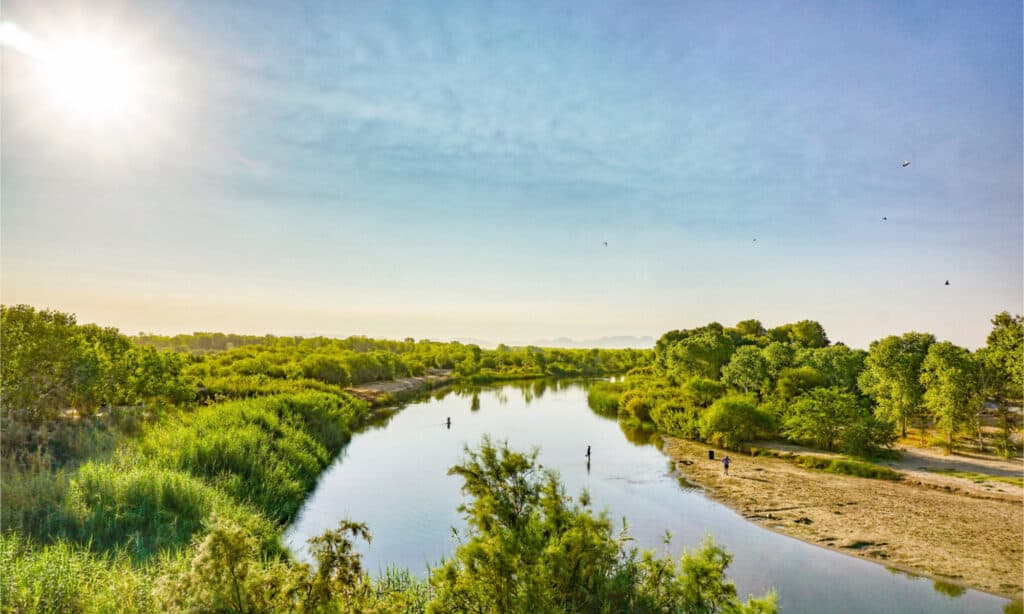
Lake Mittry is within the Lake Wildlife Area near Yuma (pictured here) on the Lower Colorado River.
©Enrique Alcala/Shutterstock.com
Mittry Lake is often overlooked due to the bigger, nearby lakes, Martinez Lake and Imperial Reservoir. However, the 750-acre water body is unique in its own way.
Mittry Lake is halfway between the upstream Imperial Dam and the downstream Laguna Dam. It’s within the Mittry Lake Wildlife Area near Yuma on the Lower Colorado River. The wildlife area features 2,400 acres of marshland and 600 acres of water surface. It also hosts a wide variety of plant and animal species. Boating around the lake is exceptional because many serpentine rivers link to the main lake body.
Due to rehabilitation efforts like marsh dredging, revegetation, and fish habitat restoration, the lake is now a fantastic spot for sport fishing.
It is open to the public for recreational uses and is public property under the management of the Arizona Game and Fish Department, the Bureau of Reclamation, and the Bureau of Land Management.
In 2016, reports emerged about the invasion of southern banded water snakes at Mittry Lake and other Colorado rivers in the Yuma region. Richard Meyers, an Arizona Game and Fish wildlife manager, reported the collection of over 20 southern banded water snakes and speculated there could be thousands more in the waters.
The Mittry Lake attracts these snake species because of its still water and cattails, a replica of snakes’ native swamps in Florida. The region’s richness of crustaceans, amphibians, and fish species attracts other animals as well.
Although they are not venomous, Arizona Game & Fish is worried about how the snakes will affect other species. Native species, such as the protected giant garter snake, compete with them for resources and may eventually become extinct.
#4 Lake Powell
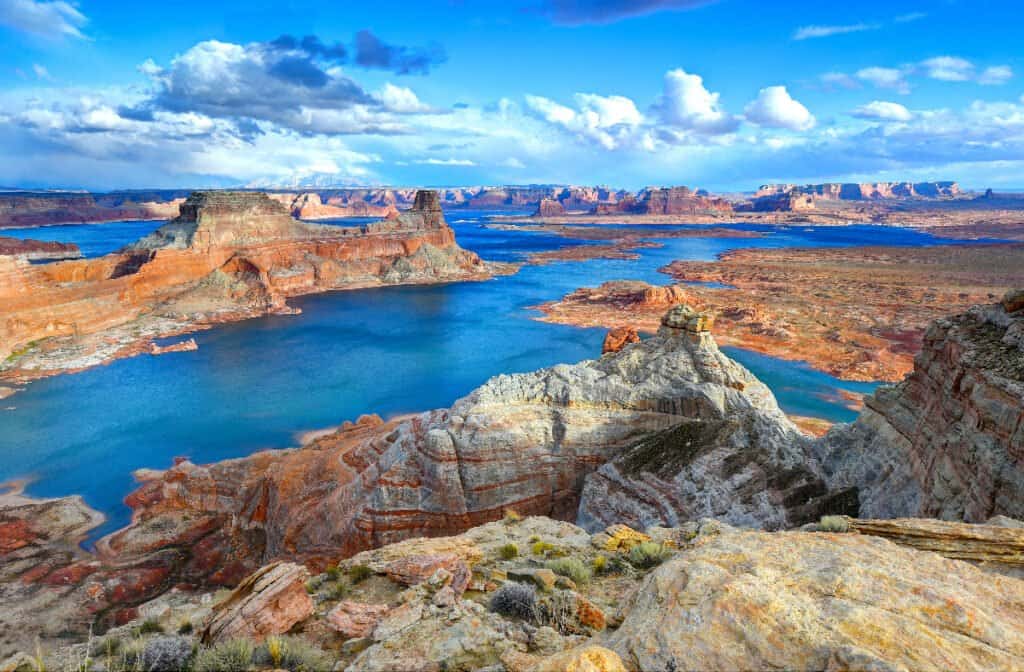
Rattlesnake species are the only venomous snakes around Lake Powell.
©worldswildlifewonders/Shutterstock.com
By maximum water capacity, Lake Powell is second only to Lake Mead among artificial reservoirs in the country. A small part of the lake is in Coconino County, northern Arizona, while most are in southern Utah’s Garfield, Kane, and San Juan counties.
Glen Canyon National Recreation Area, a popular summer vacation spot on public land overseen by the National Park Service, was established in 1972 due to the Glen Canyon Dam’s flooding of the canyon, which also caused the construction of Lake Powell.
Many migratory animals rely on Lake Powell and the Colorado River as their primary water sources. Thus, you’re likely to see wildlife from a boat on Powell. Common snake species around the lake include the common kingsnake, western rattlesnake and its subspecies (midget faded rattlesnake, Grand Canyon rattlesnake, Great Basin rattlesnake, and Hopi rattlesnake), night snake, black-necked garter snake, striped whipsnake, gopher snake, and many others.
Rattlesnake species are the only venomous snakes around Lake Powell. They see humans as potential predators, respect their space and avoid attacking it in self-defense.
#5 Lake Mohave
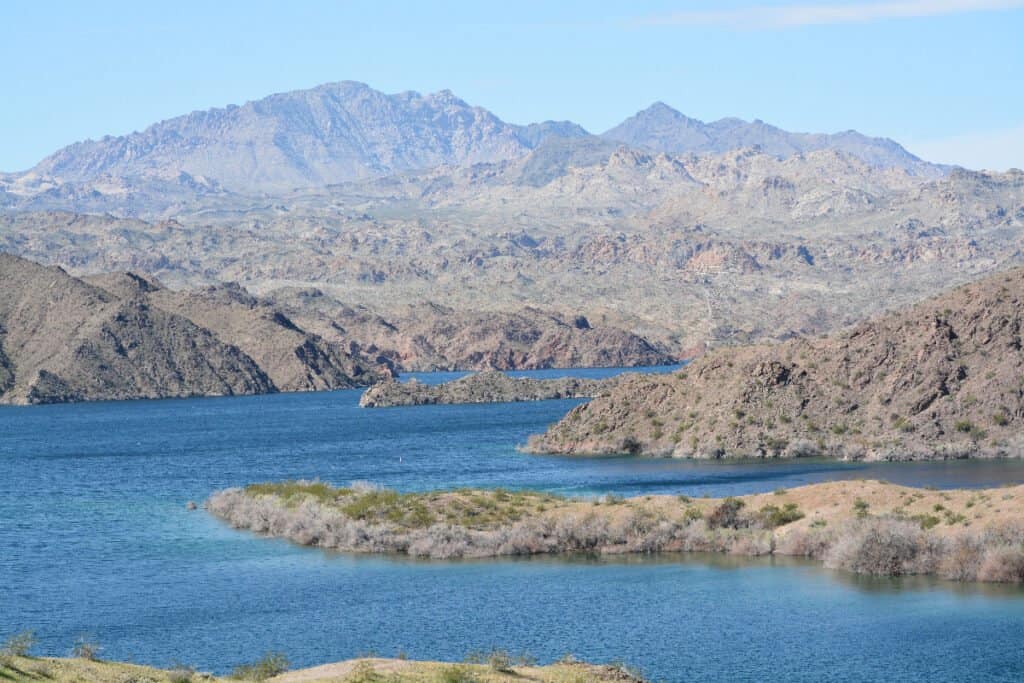
Luxurious Lake Mohave flows 67 miles from Hoover Dam to Davis Dam, crossing the border between southern Nevada and northwest Arizona.
©Norm Lane/Shutterstock.com
Lake Mohave is the other lake within Lake Mead National Recreation Area. It’s not as wide and deep as Lake Mead, but its strength is in the steep walls of Eldorado, Pyramid, Painted, and Black canyons.
It’s south of the Hoover Dam and popular for sandy coves, ferocious open waters, and the serene Black Canyon. It was created on the Colorado River in 1951 after the construction of Davis Dam near Laughlin, Nevada, and Bullhead City in Arizona.
It flows about 67 miles from Hoover Dam to Davis Dam, crossing the border between southern Nevada and northwest Arizona.
The water in Lake Mohave is warm enough to swim all year round. While its desert offers rewarding hiking, wildlife photography, and roadside sightseeing opportunities, its clear water appeals to swimmers, anglers, and boaters.
Many desert fauna and flora species thrive around Lake Mohave, adapting to the habitat with little rain and high temperatures.
Western diamondback rattlesnakes are widespread in this region, according to Kingman’s Arizona Game & Fish office. The Mohave rattlesnake, popularly known as Mojave green, is presumably the second most prevalent. It’s also possible to see Arizona black rattlesnakes, black-tailed rattlesnakes, and sidewinder rattlesnakes.
Typically, rattlesnakes make a point of avoiding people, and they won’t even rattle unless they believe they have been seen. Rather, they prefer to move silently and deploy their natural camouflage. However, it gets tricky here; their silence could result in biting unsuspecting persons. Their venom, known as hemotoxin, affects the red blood cells and damages tissues.
Always be mindful of where you place your hands and feet. Thus, avoid going anywhere with dense shrubbery.
Summary of the Most Snake-Infested Lakes in Arizona
| Rank | Lakes | Snakes Found |
|---|---|---|
| 1 | Lake Mead | Mojave Rattlesnake, Western Diamondback Rattlesnake, Southwestern Speckled Rattlesnake, Sidewinder, and king snake. |
| 2 | Lake Pleasant | Rattlesnakes |
| 3 | Mittry Lake | Southern banded water snakes |
| 4 | Lake Powell | Common king snake, western rattlesnake, gopher snake, striped whipsnake, night snake, and black-necked garter snake. |
| 5 | Lake Mohave | Mohave rattlesnake, sidewinder, western diamondback, Arizona black rattlesnake, black-tailed rattlesnake. |
Other Animals Found Near Lakes in Arizona
Gila Monster
Gila monsters are a venomous lizard species indigenous to the Southwestern United States and the northwestern Mexican state of Sonora. They inhabit dry, arid habitats and the Lake Mead National Recreation Area. The sluggish-moving reptiles are one of the few venomous lizards worldwide and the only species native to the United States.
They were first found in Arizona’s Gila River Basin, hence the name. Gila monsters are protected by Arizona state law; they were the first venomous animal species to receive legal protection in North America.
Their black bodies are coated in bead-like scales with vivid pink, orange, or yellow patches or bands, and they can grow up to 22 inches (0.56 meters). They primarily consume stolen eggs from bird nests and young mammals such as squirrels and rabbits.
No human deaths have been reported, although the Gila monster’s bite is excruciatingly painful.
Mountain Lion
Whether you call them panthers, cougars, or puma, mountain lions are prevalent in the Americas, including across Arizona, with recorded sightings around lakes Mead, Powell, and Pleasant.
The large cat species are often alone, except when paired for breeding or when females carry their kittens.
They are predatory and can kill and injure humans, but they are rarely seen by humans. The Arizona Game and Fish Department advised looking out for, among other things, huge tracks without claw traces, hidden leftover kill, and large segmented cylindrical droppings.
Conclusion
When visiting known snake-infested Arizonan lakes in Arizona, it is crucial to follow preventive measures. While the snakes help to maintain a balanced ecosystem, they can harm unwary humans. So, keep a safe distance from snakes and other wildlife as you enjoy the warmth and beauty of Arizona’s lakes.
The photo featured at the top of this post is © Rafael R Sandoval/Shutterstock.com
Discover the "Monster" Snake 5X Bigger than an Anaconda
Every day A-Z Animals sends out some of the most incredible facts in the world from our free newsletter. Want to discover the 10 most beautiful snakes in the world, a "snake island" where you're never more than 3 feet from danger, or a "monster" snake 5X larger than an anaconda? Then sign up right now and you'll start receiving our daily newsletter absolutely free.
Thank you for reading! Have some feedback for us? Contact the AZ Animals editorial team.







